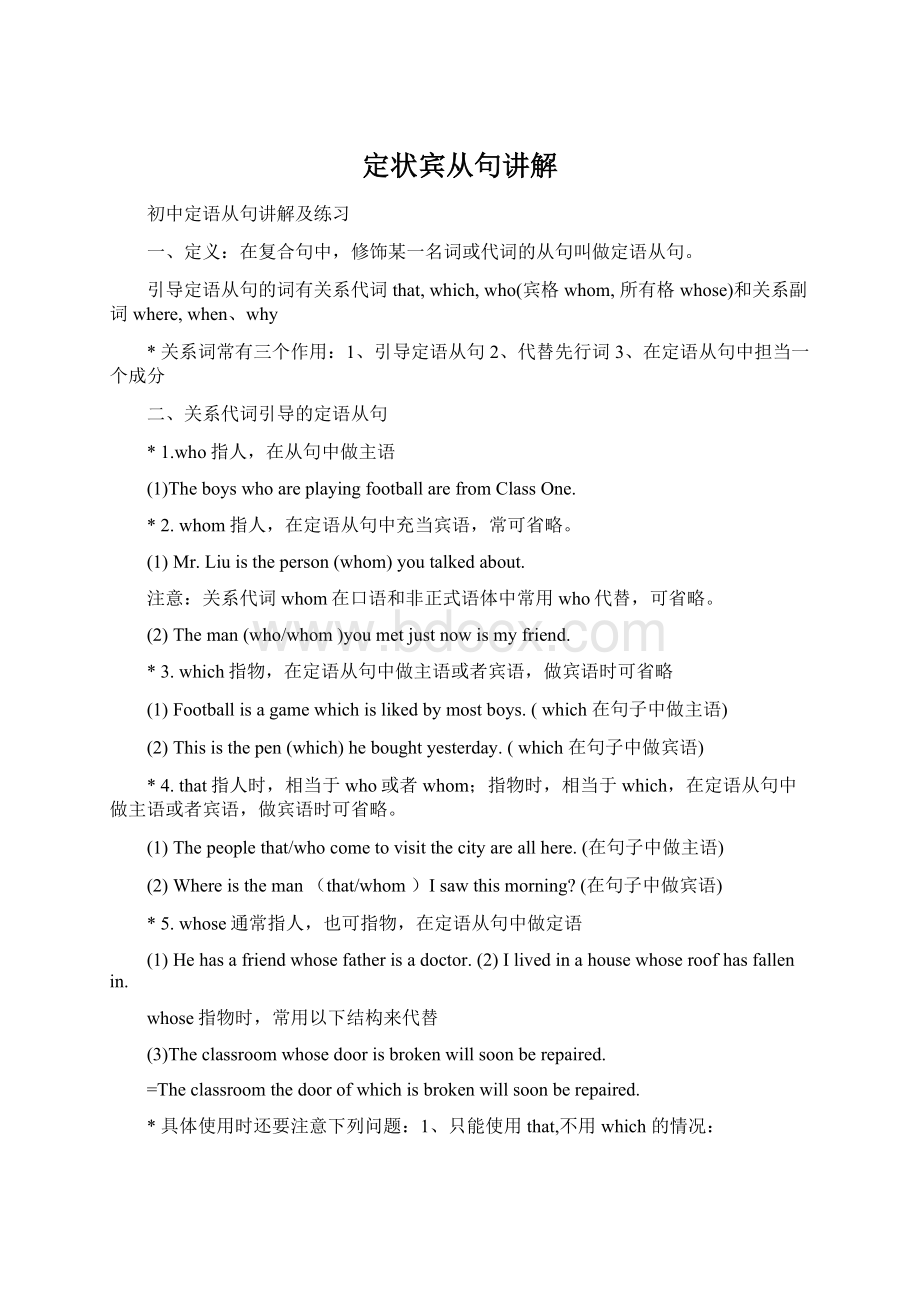定状宾从句讲解.docx
《定状宾从句讲解.docx》由会员分享,可在线阅读,更多相关《定状宾从句讲解.docx(14页珍藏版)》请在冰豆网上搜索。

定状宾从句讲解
初中定语从句讲解及练习
一、定义:
在复合句中,修饰某一名词或代词的从句叫做定语从句。
引导定语从句的词有关系代词that,which,who(宾格whom,所有格whose)和关系副词where,when、why
*关系词常有三个作用:
1、引导定语从句2、代替先行词3、在定语从句中担当一个成分
二、关系代词引导的定语从句
*1.who指人,在从句中做主语
(1)TheboyswhoareplayingfootballarefromClassOne.
*2.whom指人,在定语从句中充当宾语,常可省略。
(1)Mr.Liuistheperson(whom)youtalkedabout.
注意:
关系代词whom在口语和非正式语体中常用who代替,可省略。
(2)Theman(who/whom)youmetjustnowismyfriend.
*3.which指物,在定语从句中做主语或者宾语,做宾语时可省略
(1)Footballisagamewhichislikedbymostboys.(which在句子中做主语)
(2)Thisisthepen(which)heboughtyesterday.(which在句子中做宾语)
*4.that指人时,相当于who或者whom;指物时,相当于which,在定语从句中做主语或者宾语,做宾语时可省略。
(1)Thepeoplethat/whocometovisitthecityareallhere.(在句子中做主语)
(2)Whereistheman(that/whom)Isawthismorning?
(在句子中做宾语)
*5.whose通常指人,也可指物,在定语从句中做定语
(1)Hehasafriendwhosefatherisadoctor.
(2)Ilivedinahousewhoseroofhasfallenin.
whose指物时,常用以下结构来代替
(3)Theclassroomwhosedoorisbrokenwillsoonberepaired.
=Theclassroomthedoorofwhichisbrokenwillsoonberepaired.
*具体使用时还要注意下列问题:
1、只能使用that,不用which的情况:
*1)当先行词是:
all,any,anything,everything,nothing或被它们修饰时。
IsthereanythingthatIcandoforyou?
有什么可以为你做的吗?
Allthatcanbedonemustbedone.凡是能做的都必须做。
*2)当先行词被形容词的最高级或序数词修饰时。
例如:
Thatisoneofthemostinterestingbooksthataresoldinthebookshop.
Thefirstthingthatweshoulddoistogetsomefood.
*3)当先行词有:
theonly,thevery,thesame,thelast等修饰时。
例如:
Mynecklaceisnottheonlythingthat'smissing.
*4)当主句以who或which开头时,定语从句中引导词用that,不用which或who,以避免重复。
例如:
Whoisthegirlthatiswearingaredcoat?
*5)当先行词既有人又有物时,用that。
Thewriterandhisnovelthatyouhavejusttalkedaboutarereallywellknown.
2、只用which不用that的情况:
*1)关系代词前有介词时;e.g.ThisistheroominwhichLuXunlived.
*2)非限定性定语从句中;作宾语用的关系代词也不能省略。
Thatnecklace,whichyougavemeasapresent,waslostyesterday./Hehasadaughter,whoworksinahospital.
*3)先行词本身是that时;e.g.Theclockisthatwhichtellsthetime
非限定性定语从句的作用是对所修饰的成分作进一步说明,通常是引导词和先行词之间用逗号隔开,将从句拿掉后其他部分仍可成立。
CharlesSmith,whowasmyformerteacher,retiredlastyear./Thereissomebodyherewhowantstospeaktoyou*4)which还有一种特殊用法,它可以引导从句修饰前面的整个主句,代替主句所表示的整体概念或部分概念。
在这种从句中,which可以作主语,也可以作宾语或表语,多数情况下意思是与andthis相似,并可以指人。
Hedidverywellinthecompetition,whichmadehisparentsveryhappy.
*关系代词whom,which在定语从句中作介词宾语时,可以和介词一起放于先行词与定语从句之间,有时为了关系紧凑也可以将whom与which与先行词紧挨着书写,而将介词置于定语从句的后面,
Thatwastheroominwhichwehadlivedfortenyears.=Thatwastheroomwhichwehadlivedinfortenyears.
*像listento,lookat,takecareof等固定短语动词,在定语从句中一般不宜将介词与动词分开。
例如:
Thisistheboywhomshehastakencareof.
三、关系副词引导的定语从句
*1、when:
当主句中的先行词(即主句中被后面定语从句修饰的词)是表示时间意义的名词时,它只能作定语从句的时间状语,放在定语从句句首。
如果定语从句的引导词是作该定语从句的主语或宾语,则要改用关系代词that或which来引导。
例如:
I’llneverforgetthetimewhenweworkedonthefarm.HearrivedinBeijingonthedaywhenIleft.
I'llneverforgetthedaywhenIwasborn.(=I'llneverforgetmybirthday.)我永远不会忘记我出生的日子。
IthappenedinNovemberwhentheweatherwaswetandcold.这事发生在天气又湿又冷的十一月。
Theday(that)Ialwaysrememberinallmylifeismybirthday.我一生中最难忘的日子是我的生日。
(that作定语从句"thatIalwaysrememberinallmylife"的宾语,that可以省略)
*2、where:
当主句中的先行词是表示地点意义的名词时,它只能作其所在的定语从句的地点状语,放在定语从句的句首。
如果定语从句的引导词作该定语从句的主语或宾语时,也要改用关系代词that或which来引导。
例如:
ThefactorywherehisfatherworksisintheeastofthecityThisistheroomwhere(=inwhich)Ilivedlastyear.
Let'slookforaplacewherewecanswim.Thatisthefactory(that)theyvisitedlastmonth.
*注意:
不要以为在时间名词后就一定用关系副词when,在地点名词后就一定用关系副词where,在表示原因的thereason后就一定用关系副词why。
到底选用关系副词还是关系代词,关键是看它们在从句中是用作状语(用关系副词)还是用作主语或宾语(用关系代词)。
如:
Don’tforgetthetime(that)I’vetoldyou.(that用作told的宾语)
I’llneverforgetthedayswhenIworkedwithyou.(when用作状语)
Heworksinafactorythat/whichmakesradioparts.(that/which在从句中用作主语,且不能省略)
Heworksinthefactorywherehisfatherworked.where作状语)
That’sthereason(that/which)heexplainedtous.(that或which在从句中用作explained的宾语)That’sthereasonwhyshelefthome.那就是她离家出走的原因。
(why在从句中作状语)
*英语中的关系副词主要是when,where,why三个,不要想当然地将how用作关系副词修饰theway。
如不说Thisisthewayhowhespoke,可改为Thisishowhespoke(how引导的是表语从句),
当然也可说成Thisistheway(that/inwhich)hespoke.(其中的that/inwhich可省略)
*另外,when和where可引导限制性和非限制性定语从句,而why则只用于引导限制性定语从句,不用于引导非限制性定语从句。
Sundayisaholiday,whenpeopledonotgotowork.
Hetookusintotheclassroom,wheretherewereonlyafewstudents.
*在定语从句的使用中,oneof后面的名词是复数,这个复数名词制约后面的定语从句的谓语动词,用复数;而在oneof前面有the或theonly时,后面引导的定语从句中的谓语动词则用单数形式。
Heistheonlyoneofthestudentswhoiselected?
Jasperisoneofthosepeoplewhoknowabouttheaccident.
状语从句
状语从句主要用来修饰主句或主句的谓语。
一般可分为九大类,分别表示时间、地点、原因、目的、结果、条件、让步、比较和方式。
尽管种类较多,但由于状语从句与汉语结构和用法相似,所以理解和掌握它并不难。
状语从句的关键是要掌握引导不同状语从句的常用连接词和特殊的连接词即考点。
现分别列举如下:
1.时间状语从句常用引导词:
when,as,while,assoonas,while,before,after,since,till,until特殊引导词:
theminute,themoment,thesecond,everytime,theday,theinstant,immediately,directly,nosooner…than,hardly…when,scarcely…whenIdidn’trealizehowspecialmymotherwasuntilIbecameanadult.WhileJohnwaswatchingTV,hiswifewascooking.Thechildrenranawayfromtheorchard(果园)themomenttheysawtheguard.NosoonerhadIarrivedhomethanitbegantorain.EverytimeIlistentoyouradvice,Igetintotrouble.2.地点状语从句常用引导词:
where特殊引导词:
wherever,anywhere,everywhereGenerally,airwillbeheavilypollutedwheretherearefactories.Whereveryougo,youshouldworkhard.3.原因状语从句常用引导词:
because,since,as,since特殊引导词:
seeingthat,nowthat,inthat,consideringthat,giventhat,consideringthat,MyfriendsdislikemebecauseI’mhandsomeandsuccessful.Nowthateverybodyhascome,let’sbeginourconference.Thehigherincometaxisharmfulinthatitmaydiscouragepeoplefromtryingtoearnmore.Consideringthatheisnomorethan12yearsold,hisheightof1.80misquiteremarkable.4.目的状语从句常用引导词:
sothat,inorderthat特殊引导词:
lest,incase,forfearthat,inthehopethat,forthepurposethat,totheendthatThebossaskedthesecretarytohurryupwiththeletterssothathecouldsignthem.Theteacherraisedhisvoiceonpurposethatthestudentsinthebackcouldhearmoreclearly.5.结果状语从句常用引导词:
so…that,so…that,such…that,特殊引导词:
suchthat,tothedegreethat,totheextentthat,tosuchadegreethat,Hegotupsoearlythathecaughtthefirstbus.It’ssuchagoodchancethatwemustnotmissit.Tosuchandegreewasheexcitedthathecouldn’tsleeplastnight.6.条件状语从句常用引导词:
if,unless,特殊引导词:
as/solongas,onlyif,providing/providedthat,supposethat,incasethat,onconditionthatWe’llstartourprojectifthepresidentagrees.Youwillcertainlysucceedsolongasyoukeepontrying.Providedthatthereisnoopposition,weshallholdthemeetinghere.7.让步状语从句常用引导词:
though,although,evenif,eventhough特殊引导词:
as(用在让步状语从句中必须要倒装),while(一般用在句首),nomatter…,inspiteofthefactthat,while,whatever,whoever,wherever,whenever,however,whicheverMuchasIrespecthim,Ican’tagreetohisproposal.Theoldmanalwaysenjoysswimmingeventhoughtheweatherisrough.Nomatterhowhardhetried,shecouldnotchangehermind.Hewon’tlistenwhateveryoumaysay.8.比较状语从句常用引导词:
as(同级比较),than(不同程度的比较)特殊引导词:
themore…themore…;justas…,so…;AistoBwhat/asXistoY;no…morethan;notAsomuchasBSheisasbad-temperedashermother.Thehouseisthreetimesasbigasours.Themoreyouexercise,thehealthieryouwillbe.Foodistomenwhatoilistomachine.食物之于人,犹如油之于机器。
9.方式状语从句常用引导词:
as,asif,how特殊引导词:
thewayWheninRome,doastheRomando.Shebehavedasifsheweretheboss.
Sometimesweteachourchildrenthewayourparentshavetaughtus.
10.状语从句的简化♠状语从句的省略状语从句同时具备下列两个条件:
①主句和从句的主语一
或从句主语为it;②从句主要动词是be的某种形式。
从句中的主语和be动词常可省略。
例如:
When(themuseumis)completed,themuseumwillbeopentothepublicnextyear.He’llgototheseasideforhisholidayif(itis)possible.另外,比较状语从句经常省略。
例如:
I’mtallerthanhe(istall).Thehigherthetemperature(is),thegreaterthepressure(is).就状语从句而言,有时为了使语言言简意赅,常常将状语从句进行"简化"。
状语从句的"简化"现象在口语中较为普遍,而且在高考中的复现率也较高。
因此,有必要对其进行全面、透彻的了解。
状语从句的"简化"现象常存在于以下五种状语从句中:
①由if,unless等引导的条件状语从句;②由although,though,evenif/though等引导的让步状语从句;③由when,while,as,before,after,until/till等引导的时间状语从句;④由as,asif等引导的方式状语从句;⑤由as,than等引导的比较状语从句。
下面针对这五种情形作一归纳。
(1)当状语从句的主语是it,且谓语动词是be时,it和be要完全简化掉。
例如:
If(itis)possible,hewillhelpyououtofthedifficulty.
Youmustattendthemeetingunless(itis)inconvenienttoyou.
(2)当状语从句的主语和主句的主语一致时,从句可以将主语和be动词简化掉。
常用于以下几种情形:
a.连词+形容词As(hewas)young,helearnedhowtorideabike.Whenever(sheis)free,sheoftengoesshopping.Workhardwhen(youare)young,oryou'llregret.少壮不努力,老大徒伤悲。
b.连词+名词While(hewas)ayoungboy,hewasalwaysreadytohelpothers.
Although(hewas)afarmer,nowheisafamousdirector.
c.连词+现在分词As(shewas)walkingalongtheriverbank,shewassingingapopsong.Although(heis)doinghisbestinmathsthesedays,hehasstillgotnogoodmarks.
d.连词+过去分词Hewon'tgotherewithusunless(heis)invited.Theconcertwasagreatsuccessthan(itwas)expected.
e.连词+不定式Hestoodupasif(hewere)tosaysomething.Hewouldn'tsolvetheproblemevenif(hewere)totakecharge
f.连词+介词短语Shelookedanxiousasthough(shewas)introuble.
HehadmasteredtheEnglishlanguagebefore(hewas)intheUSA.注意:
当从句主语和主句主语不一致时,从句部分要么用完全形式,要么用独立主格结构来表达。
例如:
Whenthemeetingwasover(=Themeetingover),allthepeoplewentoutofthemeeting-room.
宾语从句。
1.语序
无论主句是陈述句还是疑问句,宾语从句都必须使用陈述语序,即“主句+连词+宾语从句(主语+谓语+……)”句式。
根据连接词在从句中所担任的不同成分,可分为以下四种:
1)连接词+谓语。
连接词在从句中作主语。
常见的连接词有:
who,what,which等。
如:
Couldyoutellmewhoknowstheanswer,please?
2)连接词+名词+谓语。
连接词在从句中作主语的定语。
常见的连接词有:
whose,what,which,howmany,howmuch等。
如:
Heaskedwhose